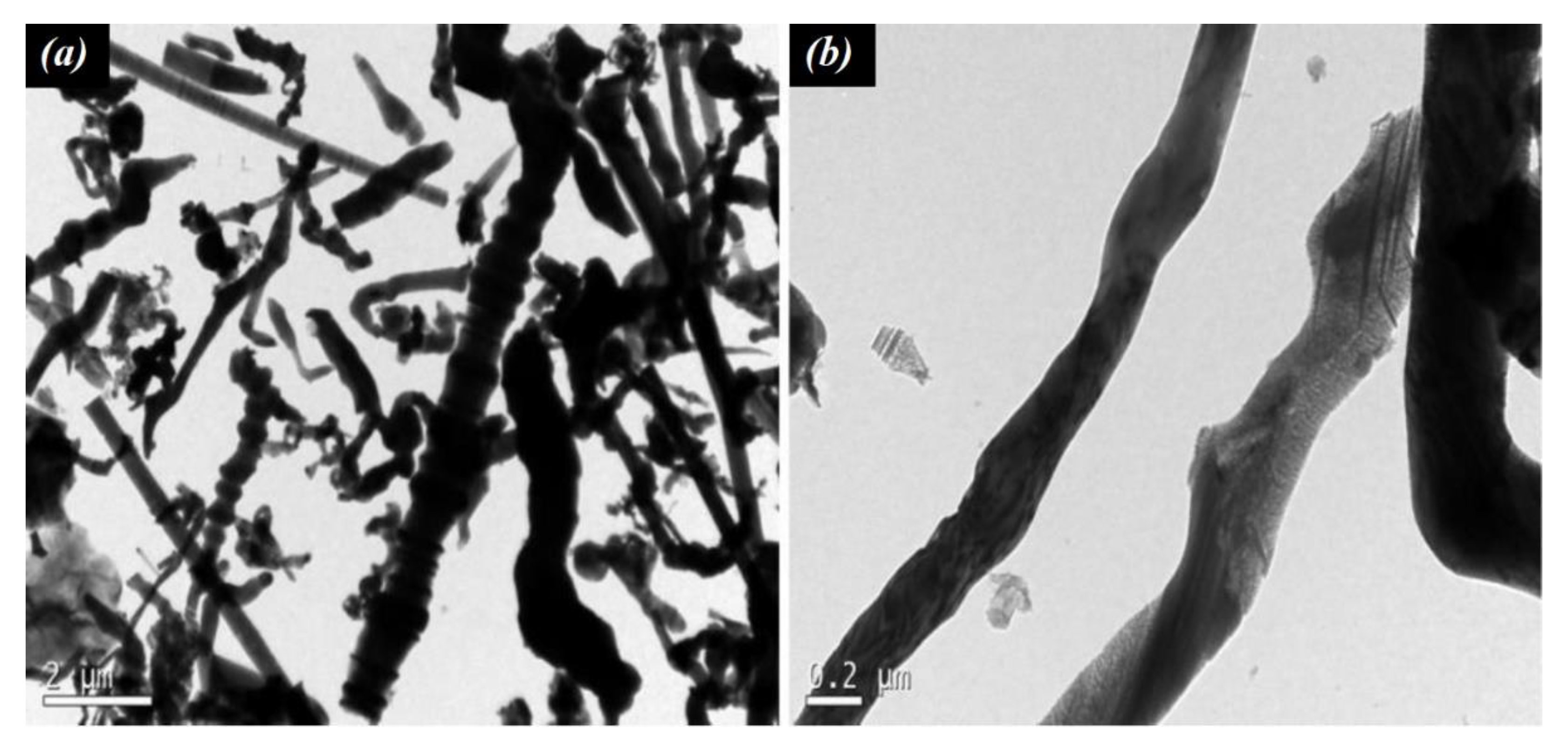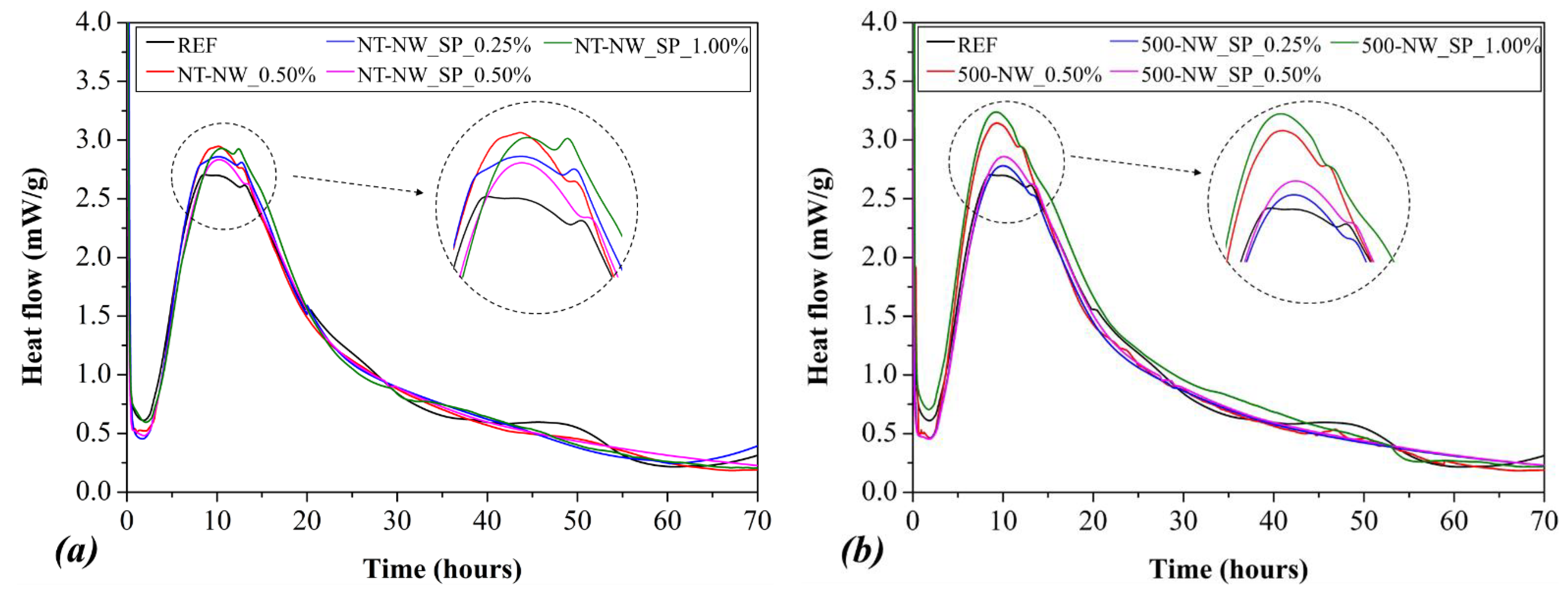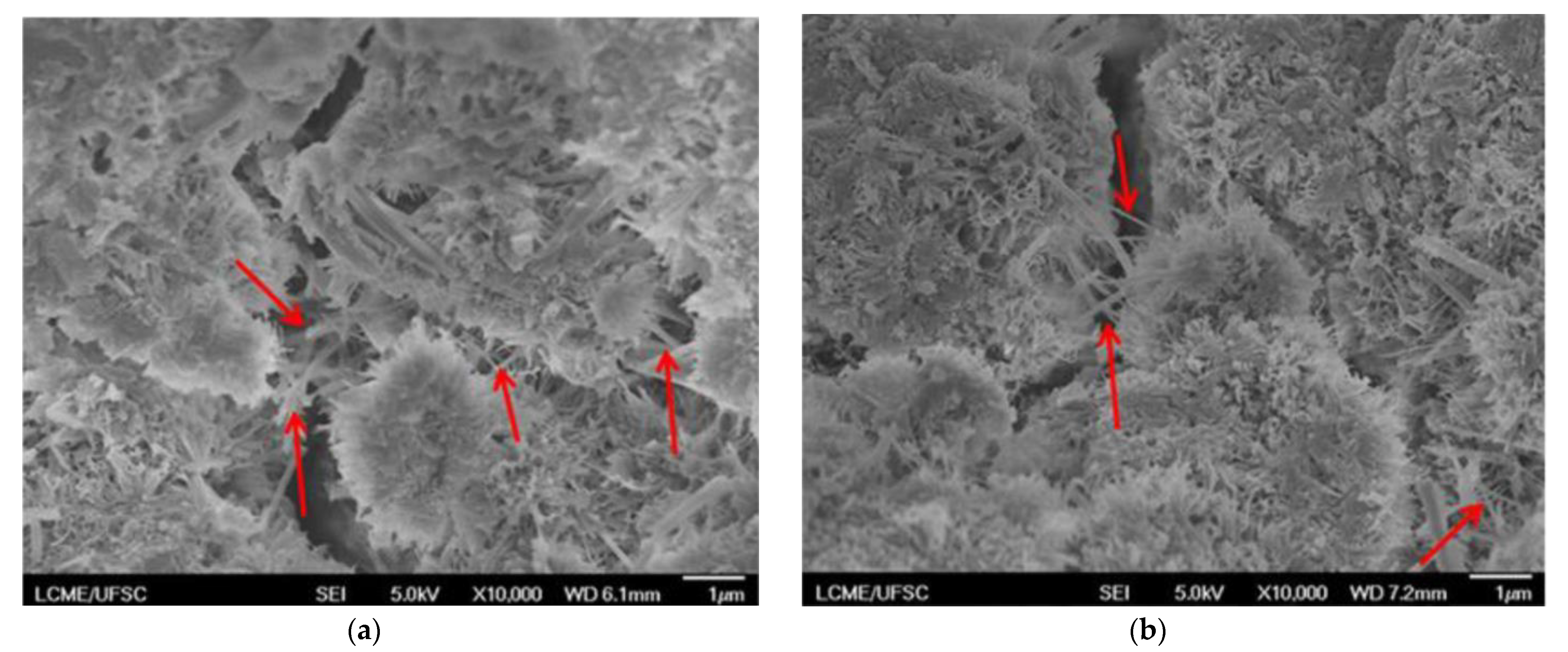Utilization of Thermally Treated SiC Nanowhiskers and Superplasticizer for Cementitious Composite Production
Abstract
:1. Introduction
2. Materials and Methods
2.1. Materials and Mixes
2.2. Sample Preparation and Testing Methods
2.3. Statistical Analysis
3. Results and Discussion
3.1. Fresh-State Properties
3.2. Cement Hydration
3.3. Hardened-State Properties
4. Conclusions
Author Contributions
Funding
Institutional Review Board Statement
Informed Consent Statement
Data Availability Statement
Acknowledgments
Conflicts of Interest
References
- Reches, Y. Nanoparticles as concrete additives: Review and perspectives. Constr. Build. Mater. 2018, 175, 483–495. [Google Scholar] [CrossRef]
- Silvestro, L.; Gleize, P.J.P. Effect of carbon nanotubes on compressive, flexural and tensile strengths of Portland cement-based materials: A systematic literature review. Constr. Build. Mater. 2020, 264, 120237. [Google Scholar] [CrossRef]
- Qing, Y.; Zenan, Z.; Deyu, K.; Rongshen, C. Influence of nano-SiO2 addition on properties of hardened cement paste as compared with silica fume. Constr. Build. Mater. 2007, 21, 539–545. [Google Scholar] [CrossRef]
- Garcia, R.; Henao, N.; De la Rubia, M.A.; Moragues, A.; Fernandez, J. Early contributing nanostructured cementitious matrix designs: Benefits in durable features at early ages. Constr. Build. Mater. 2020, 241, 117941. [Google Scholar] [CrossRef]
- Da Silva Andrade, D.; da Silva Rêgo, J.H.; Morais, P.C.; Rojas, M.F. Chemical and mechanical characterization of ternary cement pastes containing metakaolin and nanosilica. Constr. Build. Mater. 2018, 159, 18–26. [Google Scholar] [CrossRef]
- Wang, B.; Han, Y.; Liu, S. Effect of highly dispersed carbon nanotubes on the flexural toughness of cement-based composites. Constr. Build. Mater. 2013, 46, 8–12. [Google Scholar] [CrossRef]
- Batiston, E.; de Matos, P.R.; Gleize, P.J.P.; Fediuk, R.; Klyuev, S.; Vatin, N.; Karelina, M. Combined Functionalization of Carbon Nanotubes (CNT) Fibers with H2SO4/HNO3 and Ca(OH)2 for Addition in Cementitious Matrix. Fibers 2021, 9, 14. [Google Scholar] [CrossRef]
- Tyson, B.M.; Al-Rub, R.K.A.; Yazdanbakhsh, A.; Grasley, Z. Carbon nanotubes and carbon nanofibers for enhancing the mechanical properties of nanocomposite cementitious materials. J. Mater. Civ. Eng. 2011, 23, 1028–1035. [Google Scholar] [CrossRef]
- Li, G.Y.; Wang, P.M.; Zhao, X. Mechanical behavior and microstructure of cement composites incorporating surface-treated multi-walled carbon nanotubes. Carbon N. Y. 2005, 43, 1239–1245. [Google Scholar] [CrossRef]
- Al-Rub, R.K.A.; Ashour, A.I.; Tyson, B.M. On the aspect ratio effect of multi-walled carbon nanotube reinforcements on the mechanical properties of cementitious nanocomposites. Constr. Build. Mater. 2012, 35, 647–655. [Google Scholar] [CrossRef]
- Wong, E.W.; Sheehan, P.E.; Lieber, C.M. Nanobeam mechanics: Elasticity, strength, and toughness of nanorods and nanotubes. Science 1997, 277, 1971–1975. [Google Scholar] [CrossRef]
- Khan, A.; Sohail, S.; Jacob, C. The fabrication of stable superhydrophobic surfaces using a thin Au/Pd coating over a hydrophilic 3C-SiC nanorod network. Appl. Surf. Sci. 2015, 353, 964–972. [Google Scholar] [CrossRef]
- Szala, M.; Borkowski, A. Toxicity assessment of SiC nanofibers and nanorods against bacteria. Ecotoxicol. Environ. Saf. 2014, 100, 287–293. [Google Scholar] [CrossRef] [PubMed]
- Midtdal, K.; Jelle, B.P. Self-cleaning glazing products: A state-of-the-art review and future research pathways. Sol. Energy Mater. Sol. Cells 2013, 109, 126–141. [Google Scholar] [CrossRef] [Green Version]
- Carmona-Quiroga, P.M.; Martínez-Ramírez, S.; Viles, H.A. Efficiency and durability of a self-cleaning coating on concrete and stones under both natural and artificial ageing trials. Appl. Surf. Sci. 2018, 433, 312–320. [Google Scholar] [CrossRef]
- Qadri, S.B.; Gorzkowski, E.P.; Imam, M.A.; Fliflet, A.; Goswami, R.; Kim, H.; Caldwell, J.D.; Klemm, F.; Rath, B.B. Production of nanoscale particles and nanorods of SiC from sorghum leaves. Ind. Crops Prod. 2013, 51, 158–162. [Google Scholar] [CrossRef]
- Echeverria, C.A.; Pahlevani, F.; Lim, S.; Sahajwalla, V. Synthesis and characterization of biomorphic 1D-SiC nanoceramics from novel macroalga precursor material. J. Clean. Prod. 2021, 312, 127808. [Google Scholar] [CrossRef]
- Shin, Y.; Wang, C.; Samuels, W.D.; Exarhos, G.J. Synthesis of SiC nanorods from bleached wood pulp. Mater. Lett. 2007, 61, 2814–2817. [Google Scholar] [CrossRef]
- Rahman, M.H.; Al Rashed, H.M.M. Characterization of silicon carbide reinforced aluminum matrix Composites. Procedia Eng. 2014, 90, 103–109. [Google Scholar] [CrossRef] [Green Version]
- Du, F.P.; Xie, S.S.; Zhang, F.; Tang, C.Y.; Chen, L.; Law, W.C.; Tsui, C.P. Microstructure and compressive properties of silicon carbide reinforced geopolymer. Compos. Part. B Eng. 2016, 105, 93–100. [Google Scholar] [CrossRef] [Green Version]
- Shui, A.; Xi, X.; Wang, Y.; Cheng, X. Effect of silicon carbide additive on microstructure and properties of porcelain ceramics. Ceram. Int. 2011, 37, 1557–1562. [Google Scholar] [CrossRef]
- Azevedo, N.H.; Gleize, P.J.P. Effect of silicon carbide nanowhiskers on hydration and mechanical properties of a Portland cement paste. Constr. Build. Mater. 2018, 169, 388–395. [Google Scholar] [CrossRef]
- Azevedo, N.H.; de Matos, P.R.; Gleize, P.J.P.; Betioli, A.M. Effect of thermal treatment of SiC nanowhiskers on rheological, hydration, mechanical and microstructure properties of Portland cement pastes. Cem. Concr. Compos. 2021, 117, 103903. [Google Scholar] [CrossRef]
- Isfahani, F.T.; Li, W.; Redaelli, E. Dispersion of multi-walled carbon nanotubes and its effects on the properties of cement composites. Cem. Concr. Compos. 2016, 74, 154–163. [Google Scholar] [CrossRef]
- Li, X.; Liu, Y.M.; Li, W.G.; Li, C.Y.; Sanjayan, J.G.; Duan, W.H.; Li, Z. Effects of graphene oxide agglomerates on workability, hydration, microstructure and compressive strength of cement paste. Constr. Build. Mater. 2017, 145, 402–410. [Google Scholar] [CrossRef]
- Azevedo, N.H. Performance Evaluation of Portland Cement Pastes Reinforced with Silicon Carbide Nanowiskers after Heat Treatment. Ph.D. Thesis, Universidade Federal de Santa Catarina, Florianópolis, Brazil, 2019. (In Portuguese). [Google Scholar]
- EN 197-1. Composition, Specifications and Conformity Criteria for Common Cements; CEN: Brussels, Belgium, 2011.
- Kantro, D.L. Influence of water-reducing admixtures on properties of cement paste: A miniature slump test. Cem. Concr. Agreg. 1980, 2, 95–102. [Google Scholar] [CrossRef]
- De Matos, P.R.; Pilar, R.; Casagrande, C.A.; Gleize, P.J.P.; Pelisser, F. Comparison between methods for determining the yield stress of cement pastes. J. Braz. Soc. Mech. Sci. Eng. 2020, 42, 1–13. [Google Scholar] [CrossRef]
- Jakob, C.; Jansen, D.; Ukrainczyk, N.; Koenders, E.; Pott, U.; Stephan, D.; Neubauer, J. Relating ettringite formation and rheological changes during the initial cement hydration: A comparative study applying XRD analysis, rheological measurements and modeling. Materials 2019, 12, 2957. [Google Scholar] [CrossRef] [Green Version]
- Andrade Neto, J.S.; Santos, T.A.; de Andrade Pinto, S.; Dias, C.M.R.; Ribeiro, D.V. Effect of the combined use of carbon nanotubes (CNT) and metakaolin on the properties of cementitious matrices. Constr. Build. Mater. 2021, 271. [Google Scholar] [CrossRef]
- Mendoza Reales, O.A.; Jaramillo, Y.P.A.; Botero, J.C.O.; Delgado, C.A.; Quintero, J.H.; Toledo Filho, R.D. Influence of MWCNT/surfactant dispersions on the rheology of Portland cement pastes. Cem. Concr. Res. 2018, 107, 101–109. [Google Scholar] [CrossRef]
- Jiang, S.; Shan, B.; Ouyang, J.; Zhang, W.; Yu, X.; Li, P.; Han, B. Rheological properties of cementitious composites with nano/fiber fillers. Constr. Build. Mater. 2018, 158, 786–800. [Google Scholar] [CrossRef]
- Sargam, Y.; Wang, K. Hydration kinetics and activation energy of cement pastes containing various nanoparticles. Compos. Part. B Eng. 2021, 216, 108836. [Google Scholar] [CrossRef]
- Zhang, L.; Miao, X.; Kong, X.; Zhou, S. Retardation effect of PCE superplasticizers with different architectures and their impacts on early strength of cement mortar. Cem. Concr. Compos. 2019, 104, 103369. [Google Scholar] [CrossRef]
- Winnefeld, F.; Becker, S.; Pakusch, J.; Götz, T. Effects of the molecular architecture of comb-shaped superplasticizers on their performance in cementitious systems. Cem. Concr. Compos. 2007, 29, 251–262. [Google Scholar] [CrossRef]
- Mollah, M.Y.A.; Adams, W.J.; Schennach, R.; Cocke, D.L. Review of cement-superplasticizer interactions and their models. Adv. Cem. Res. 2000, 12, 153–161. [Google Scholar] [CrossRef]
- Pott, U.; Jakob, C.; Jansen, D.; Neubauer, J.; Stephan, D. Investigation of the incompatibilities of cement and superplasticizers and their influence on the rheological behavior. Materials 2020, 13, 977. [Google Scholar] [CrossRef] [PubMed] [Green Version]
- Aïtcin, P.; Flatt, R.J. Science and Technology of Concrete Admixtures; Woodhead Publishing Limited: Sawston, UK, 2016; ISBN 9780081006931. [Google Scholar]
- Scrivener, K.L.; Juilland, P.; Monteiro, P.J.M. Advances in understanding hydration of Portland cement. Cem. Concr. Res. 2015, 78, 38–56. [Google Scholar] [CrossRef]
- Zhang, Y.; Wang, Q.; Ren, Z.; Yang, Y. Preparation and characterization of mesoporous SiC/SiO2 composite nanorods. Mater. Chem. Phys. 2020, 243, 122573. [Google Scholar] [CrossRef]
- Wu, R.; Zhou, K.; Yue, C.Y.; Wei, J.; Pan, Y. Recent progress in synthesis, properties and potential applications of SiC nanomaterials. Prog. Mater. Sci. 2015, 72, 1–60. [Google Scholar] [CrossRef]
- Batiston, E.; Gleize, P.J.P.; Mezzomo, P.; Pelisser, F.; de Matos, P.R. Effect of Carbon Nanotubes (CNTs) aspect ratio on the rheology, thermal conductivity and mechanical performance of Portland cement paste. Rev. IBRACON Estrut. Mater. 2021, 14, 1–12. [Google Scholar] [CrossRef]








| Mix | OPC | NT-NW | 500-NW | Water | SP |
|---|---|---|---|---|---|
| REF | 1.0 | - | - | 0.4 | - |
| NT-NW_0.50% | 1.0 | 0.50 | - | 0.4 | - |
| NT-NW_SP_0.25% | 1.0 | 0.25 | - | 0.4 | 0.20 |
| NT-NW_SP_0.50% | 1.0 | 0.50 | - | 0.4 | 0.25 |
| NT-NW_SP_1.00% | 1.0 | 1.00 | - | 0.4 | 0.50 |
| 500-NW_0.50% | 1.0 | - | 0.50 | 0.4 | - |
| 500-NW_SP_0.25% | 1.0 | - | 0.25 | 0.4 | 0.20 |
| 500-NW_SP_0.50% | 1.0 | - | 0.50 | 0.4 | 0.25 |
| 500-NW_SP_1.00% | 1.0 | - | 1.00 | 0.4 | 0.50 |
Publisher’s Note: MDPI stays neutral with regard to jurisdictional claims in published maps and institutional affiliations. |
© 2021 by the authors. Licensee MDPI, Basel, Switzerland. This article is an open access article distributed under the terms and conditions of the Creative Commons Attribution (CC BY) license (https://creativecommons.org/licenses/by/4.0/).
Share and Cite
Azevedo, N.; Neto, J.A.; de Matos, P.; Betioli, A.; Szeląg, M.; Gleize, P. Utilization of Thermally Treated SiC Nanowhiskers and Superplasticizer for Cementitious Composite Production. Materials 2021, 14, 4062. https://doi.org/10.3390/ma14154062
Azevedo N, Neto JA, de Matos P, Betioli A, Szeląg M, Gleize P. Utilization of Thermally Treated SiC Nanowhiskers and Superplasticizer for Cementitious Composite Production. Materials. 2021; 14(15):4062. https://doi.org/10.3390/ma14154062
Chicago/Turabian StyleAzevedo, Nagilla, José Andrade Neto, Paulo de Matos, Andrea Betioli, Maciej Szeląg, and Philippe Gleize. 2021. "Utilization of Thermally Treated SiC Nanowhiskers and Superplasticizer for Cementitious Composite Production" Materials 14, no. 15: 4062. https://doi.org/10.3390/ma14154062






